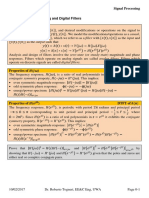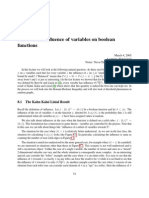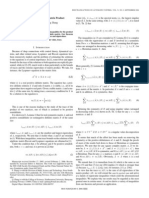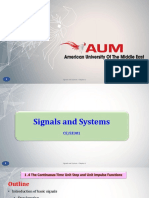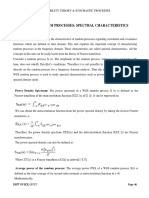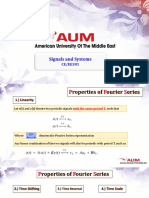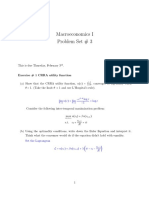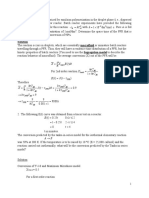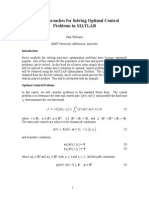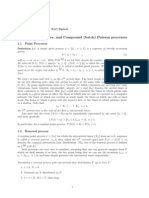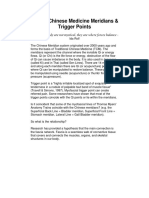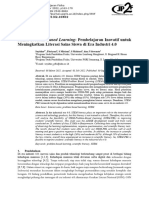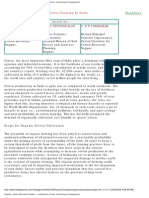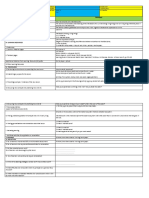1 Exy 1 S
1 Exy 1 S
Uploaded by
Lukas BoskoCopyright:
Available Formats
1 Exy 1 S
1 Exy 1 S
Uploaded by
Lukas BoskoOriginal Title
Copyright
Available Formats
Share this document
Did you find this document useful?
Is this content inappropriate?
Copyright:
Available Formats
1 Exy 1 S
1 Exy 1 S
Uploaded by
Lukas BoskoCopyright:
Available Formats
MATH TRIPOS: PART II L2011 YMS
APPLIED PROBABILITY
Example Sheet 1 (with comments)
1. Suppose X, Y and Z are exponential random variables of parameters
, and respectively. What is the distribution of W = min{X, Y, Z}?
What is the probability that Z Y ? Z Y X? Show that random
variable W and the event {Z Y X} are independent. State and prove
a similar result for n random variables. Hint: Work with tail probabilities.
2. Let T
1
, T
2
, . . . be independent exponential random variables of parameter
and let N be an independent geometric random variable with
P(N = n) = (1 )
n1
, n = 1, 2, . . . .
Show that T =
N
i=1
T
i
has exponential distribution of parameter . Show
that, n 1, the sum S =
n
i=1
T
i
has Gamma-distribution Gamma (n, ),
with the PDF f
S
(x) =
n
x
n1
(n 1)!
e
x
, x > 0. Hint: For S you may use
induction in n. For T, calculating the moment-generating function can be
useful, along with the fact that it determines the distribution uniquely.
[For S: use induction in n. For n = 1: S = T
1
Exp() Gam(1, ),
trivially. Make the induction hypothesis for n and pass to n + 1:
S
n+1
= S
n
+ T
n+1
, independently.
Thus, the PDF f
S
n+1
is given by
f
S
n+1
(x) =
_
x
0
f
Sn
(s)f
T
1
(x s)ds (the convolution formula).
Now use the induction hypothesis:
f
S
n+1
(x) =
_
x
0
n
s
n1
(n 1)!
e
s
e
(xs)
ds
= e
x
n+1
(n 1)!
_
x
0
s
n1
ds
=
n+1
x
n
n!
.
1
For T: use the above fact and sum a geometric progression or proceed
with the MGFs (also arriving at a geometric progression):
T
() = Ee
T
= E
_
E
_
e
T
N
_
_
=
n1
E
_
e
T
N = n
_
P(N = n)
=
n
(1 )
n1
_
Ee
T
1
_
n
=
1
n
_
(1 )
_
n
=
1
(1 )
__
1
(1 )
_
=
(1 )
=
.
As the MGF determines the PDF uniquely, conclude that T Exp().]
3. Prove that the determinant det e
tQ
is of the form e
tq
and hence is > 0 for
any nite Q-matrix. Can you determine q?
Hint: Use the semi-group property to calculate det e
(t+s)Q
; by analysing
the expansion at t 0 conclude that q =tr Q.
[ det e
(t+s)Q
=
_
det e
sQ
__
det e
tQ
_
, and det e
tQ
is continuous (and even
dierentiable) in t, with det e
0Q
=det I = 1. Hence, det e
tQ
= e
tq
for some
(real) q. To nd q, one can observe that
q =
d
dt
det e
tQ
t=0
=
d
dt
det (1 +tQ)
t=0
.
That is, q is the rst order coecient of the polynomial det (I + tQ) which
is precisely tr Q. Note that unless Q = 0, det e
tQ
0 as t .]
(b) Prove that the following transition probability matrices cannot be
written in the form e
Q
where Q is a 3 3 Q-matrix: (i) P =
_
_
1 0 0
1 0 0
0 1 0
_
_
,
(ii) P =
_
_
0 1 0
0 0 1
1 0 0
_
_
. Hint: it is instructive to consider the matrix P
3
.
4. State the denition of a Poisson process in terms of independent incre-
ments. Show directly from this denition that the rst jump time of a Poisson
process of rate is exponential of parameter .
2
Furthermore, show that the holding times of the process are IID expo-
nential variables of rate . Hint: Deduce the characterisation of a Poisson
process through its holding times from its characterisation through indepen-
dent increments.
[For Poisson processes, then for birth and birth and death processes and
nally for continuous-time Markov chains, there were three denitions given,
(a) in terms of the transition probabilities (in the case of a Poisson process,
in terms of increments), (b) in terms of the innitesimal probabilities, (c) in
terms of the jump chain and holding times. Many of the standard problems
revolve around the equivalence of these various denitions, so it is necessary
to make explicit which is to be regarded as the starting point. If none is
mentioned the student is free to choose the most convenient denition.
5. Assume the innitesimal denition of the Poisson process. Let p(t) de-
note the probability that the rst jump time exceeds t. By considering the
dierence p(t + h) p(t), deduce a linear diferential equation for p(t) and
solve it.
[Set p(t) = P(X
t
= 0), then
p(t + h) = P(X
t
= 0 and X
t+h
X
t
= 0)
= P(X
t
= 0)P(X
t+h
X
t
= 0) = p(t)(1 h + o(h))
so
p(t + h) p(t) = hp(t) + o(h)
uniformly in t 0. Hence p(t) is dierentiable and
p
(t) = p(t), p(0) = 1 ,
which shows p(t) = e
t
. This is a simple version of an argument used in
lectures to get the distribution of the whole process.]
6. Arrivals of the Number 1 bus form a Poisson process of rate 1 bus per
hour, and arrivals of the Number 7 bus form an independent Poisson process
of rate 7 buses per hour.
(a) What is the probability that exactly 5 buses pass by in 1 hour?
(b) What is the probability that exactly 3 Number 7 buses pass by while
I am waiting for a Number 1?
(c) When the maintenance depot goes on strike half the buses break down
before they reach my stop. What then is the probability that I wait for 30
minutes without seeing a single bus?
3
Answers: (a) e
8
8
5
/4!, (b) 7
3
/8
4
, (c) e
2
.
[Done by using y standard properties of the Poisson process.]
7. Customers arrive in a supermarket as a Poisson-process of rate N. There
are N aisles in the supermarket and each customer selects one aisle at ran-
dom, independently of the other customers. Let X
N
t
denote the proportion
of aisles which remain empty at time t and let T
N
denote the time until half
the aisles are busy. Show that
X
N
t
e
t
, T
N
log 2
in probability as N .
Hint: Identify the processses of customers arrival in each aisle and relate
them to the event {T
N
> t}.
[Customers arrive in each aisle as independent Poisson processes of rate
1. Let Y
i
t
be the indicator function of the event that the ith aisle is empty at
time t. Then Y
1
t
, . . . , Y
N
t
are independent Bernoulli with P(Y
i
t
= 1) = e
t
.
By the law of large numbers
X
N
t
= N
1
(Y
1
t
+ + Y
N
t
) e
t
almost surely as N . Since {T
N
> t} = {X
N
t
1/2} it follows that
P(T
N
> t)
_
1 if t < ln 2,
0 if t > ln 2,
so T
N
ln 2 in probability.]
8. A pedestrian wishes to cross a single lane of fast-moving trac. Suppose
the number of vehicles that have passed by time t is a Poisson process of
rate , and suppose it takes time a to walk across the lane. Assuming the
pedestrian can foresee correctly the times at which vehicles will pass by, how
long on average does it take to cross over safely?
Hint: Let T be the time to cross and J
1
the ttime at which the rst
car passes. Identify the contributions to E T from the events {J
1
> a} and
{J
1
< a}.
How long on average does it take to cross two similar lanes (a) when one
must walk straight across, (b) when an island in the middle of the road makes
it safe to stop half way?
4
[Let T be the time to cross and J
1
the time at which the rst car passes.
Then
E(T) = aP(J
1
> a) +
_
a
0
(s +E(T))e
s
ds
= (1 e
a
) (E(T) + 1/) .
Hence E(T). Check correct as 0. Walking straight across replaces a by
2a and by 2, because the sum of two independent Poisson processes of rate
is a Poisson process of rate 2. Using an island, it takes twice as long on
average as a single lane. How much quicker is it to use an island?]
9. Customers enter a supermarket as a Poisson process of rate 2. There are
two salesmen near the door who oer passing customers samples of a new
product. Each customer takes an exponential time of parameter 1 to think
about the new product, and during this time occupies the full attention of
one salesman. Having tried the product, customers proceed into the store
and leave by another door. When both salesmen are occupied, customers
walk straight in. Assuming that both salesmen are free at time 0, nd the
probability that both are busy at a later time t.
Hint: Find out the 3 3 Q-matrix and work with its eigen-values. Viz.,
q
21
= 2.
[There are three states: 0 (both salesmen are free), 1 (one busy, one free)
and 2 (both busy). The non-zero jump rates are
q
01
= , q
10
= , q
12
= , q
21
= 2,
with = 2, = 1. This leads to the Q-matrix
_
_
2 2 0
1 3 2
0 2 2
_
_
,
with q
(2)
00
= 6 and the eigen-values 0, 2, 5. Then
p
00
(t) = A + Be
2t
+ Ce
5t
, t 0,
where
A+ B + C = 1, 2B 5C = 2, 4B + 25C = 6.
Hence, A = 1/5, B = 2/3, C = 2/15, and
P
0
(both free at time t) =
1
5
+
2
3
e
2t
+
2
15
e
5t
,
5
P
0
(both busy at time t) =
2
5
2
3
e
2t
+
4
15
e
5t
.]
10. Let (X
t
)
t0
be a Markov chain on the integers with transition rates
q
ii+1
= q
i
, q
ii1
= q
i
, and q
i
= 0 if |j i| 2, where + = 1 and q
i
> 0
for all i. Find for all i
(a) The probability, starting from 0, that X
t
hits i. Hint: The answer
depends on the value of the /, viz., for /mu 1, h
i
0
=
_
(/)
i
, i 0,
1, i 0.
(b) The expected total time spent in state i, starting from 0. Answer:
h
i
0
__
q
i
| |
_
.
In the case = 0 (jumps to the right), write down a necessary and sucient
condition for (X
t
)
t0
to be explosive. Why is this condition necessary for
(X
t
)
t0
to be explosive for all [0,
1
2
)? Show that, in general, (X
t
)
t0
is
non-explosive if and only if one of the following conditions holds:
(i) = , (Hint: In this case the jump chain is recurrent.)
(ii) > and
i=1
1/q
i
= ,
(iii) < and
1
i=
1/q
i
= .
[If h
k
= P
k
(hit i) then, as usually, h
i
= 1 and (Qh)
k
= 0 for k = i. That
is,
q
k
h
k+1
+ q
k
h
k1
= q
k
h
k
, or (h
k1
h
k
) = (h
k
h
k1
), k = i.
Then, with h
+
= h
i+1
,
h
k
= h
i
+
ki
l=1
(h
i+l
h
i+l1
) = 1 + (h
+
1)
ki
l=1
_
_
l
, k i.
Similarly, with h
= h
i1
,
h
k
= h
i
+
ik
l=1
(h
il
h
il1
) = 1 + (h
1)
ik
l=1
_
_
l
, k i.
6
Parameters h
have to be xed so that the solution is minimal non-negative.
This yields
h
k
_
_
= (/)
ki
, k i, if ,
= (/)
ik
, k i, if ,
= 1, otherwise.
. . . . . . . . . . .
k i
.
.
. . . h
k
=
1
h
k
=
>
(
/
)
k
_
i
. . . . . . . . . . .
k i
. . .
.
.
h
k
=
1
>
h
)
i
_
k
/
(
=
k
. . . . . . . . . . .
k i
h
k
=
1
=
. . . . . . .
Substituting k = 0:
h
0
= P
0
(hit i) =
_
_
(/)
i
, i 0, if ,
(/)
i
, i 0, if ,
1, otherwise.
It useful to observe that k the return probability to a state k equals
P
k1
(hit k) + P
k+1
(hit k) = 2 min [, ].
Next, E
0
(time at i) = q
1
i
E
0
( # of visits to i), so introduce
E
k
= E
k
( # of visits to i) = P
k
(hit i)(1 +E
i
) = h
k
(1 +E
i
),
7
where, i,
E
i
= E
i
(# of visits to i)
=
n1
nP
i
(# of visits to i is n)
=
n0
P
i
(# of visits to i is n)
=
n0
(2 min [, ])
n
=
1
1 2 min [, ]
=
1
| |
.
So,
E
0
(time at i) =
h
0
q
i
| |
.
Now assume that , i.e., 0 1/2. If = 0, then (X
t
)
t0
is
explosive if and only if
i=1
1/q
i
< . If 0 < 1/2 then certainly the
jump chain Y
n
as n . Hence, (X
t
)
t0
cannot explode to , but
comparison with the case = 0 shows that if
i=1
1/q
i
= then (X
t
)
t0
cannot explode to either. To see that this condition is also necessary for
non-explosion when 0 < 1/2, observe that (X
t
)
t0
makes only nitely
many visits to states i 0 and
E
0
(total time at states i > 0) =
i=1
1/( )q
i
.
Finally, in the case = , (Y
n
)
n0
is recurrent so (X
t
)
t0
does not explode.
This covers cases (i) and (ii). Case (iii) is considered similarly.]
11. Let (X
t
)
t0
be a birth-and-death process with rates
n
= n and
n
=
n, and suppose X
0
= 1. Show that h(t) = P(X
t
= 0) satises
h(t) =
_
t
0
e
(+)s
{ + h(t s)
2
}ds
and deduce that if = then
h(t) = (e
t
e
t
)/(e
t
e
t
) .
Hint: If the population reaches level n then it will become extinct i
each of the n independent descendants trees terminates.
8
[A crucial point is that, with
n
= n and
n
= n, every member of the
population produces an ospring or dies independently. Therefore, the pop-
ulation with n members becomes extinct i the descendants trees generated
by each member terminates, which occurs independently. Thus we can write:
h(t) = P(X
t
= 0|X
0
= 1)
=
_
t
0
e
(+)s
( + )
_
+
+
+
P(X
t
= 0|X
s
= 2)
_
ds
=
_
t
0
e
(+)s
[ + P(X
t
= 0|X
s
= 2)]ds.
Now: P(X
t
= 0|X
s
= 2) = h(t s)
2
, and
h(t) =
_
t
0
e
(+)s
[ + h(t s)
2
)]ds
=
+
_
1 e
(+)t
_
+
_
t
0
e
(+)s
h(t s)
2
ds
=
+
_
1 e
(+)t
_
+
_
t
0
e
(+)(tu)
h(u)
2
du.
This leads to the equation
e
(+)t
h(t) =
+
_
1 e
(+)t
_
+
_
t
0
e
(+)u
h(u)
2
du,
or, after dierentiation:
( + )h + h
= + h
2
,
i.e.
dh
+ h
2
( + )h
= dt,
or
_
h
1
h 1
_
dh = dt( ),
whence
log
h
h 1
= ( )t + c,
or
h = A(h 1)e
()t
.
From h(0) = 0: A = , and
h( e
()t
) = e
()t
9
which immediately leads to the answer.]
12. Each bacterium in a colony splits into two identical bacteria after an
exponential time of parameter , which then split in the same way but inde-
pendently. Let X
t
denote the size of the colony at time t, and suppose X
0
= 1.
Show that the probability generating function (t) = E(z
Xt
) satises
(t) = ze
t
+
_
t
0
e
s
(t s)
2
ds
and deduce that, for q = 1 e
t
, and n = 1, 2, . . .,
P(X
t
= n) = q
n1
(1 q) .
Hint:Take 0 s t. Conditional on the rst split time J
1
= s, X
t
is
decomposed as X
ts
+
X
ts
.
[For 0 s t, the conditional distribution of X
t
, given the rst split J
1
occurs at s, is the same as the distribution of X
ts
+
X
ts
, where
X is an
independent copy of X. So
E(z
Xt
|J
1
= s) =
_
E(z
X
ts
+
X
ts
) for 0 s t,
z for s t,
and
(t) =
_
0
e
s
E(z
Xt
|J
1
= s)ds
= ze
t
+
_
t
0
e
s
(t s)
2
ds .
Put u = t s, multiply by e
t
and dierentiate to see that d/dt = (1 )
and so e
t
= z( 1)/(z 1). Then
(t) =
n=1
(1 q(t))q(t)
n1
z
n
where q = 1 e
t
.]
13. Compute p
11
(t) for P(t) = e
tQ
, where
Q =
_
_
2 1 1
4 4 0
2 1 3
_
_
.
10
Find an invariant distribution for Q and verify that p
11
(t)
1
as t .
[The eigenvalues of Q are 0, 4, 5 so p
11
(t) = A+Be
4t
+Ce
5t
for some
constants A, B, C which may be determined from p
11
(0) = 1, p
11
(0) = 2,
p
11
(0) = q
(2)
11
= 10. In fact, A =
3
5
=
1
, B = 0, C =
2
5
.]
14. Two eas are bound together to take part in a nine-legged race on the
vertices A, B, C of a triangle. Flea 1 hops at random times in the clockwise
direction; each hop takes the pair from one vertex to the next and the times
between successive hops of Flea 1 are independent random variables, each
with with exponential distribution, mean 1/. Flea 2 behaves similarly, but
hops in the anti-clockwise direction, the times between his hops having mean
1/. Show that the probability that they are at A at a given time t > 0 is
1
3
+
2
3
exp
_
3( + )t
2
_
cos
_
3( )t
2
_
.
[The position evolves as a Markov chain with Q-matrix
Q =
_
_
_
_
and the problem is to compute p
11
(t). The method of Example 1 applies.
Convergence to equilibrium gives p
11
() =
1
3
, which is useful in xing the
constants.]
11
You might also like
- Modelos Estoc Asticos 2: Christian OjedaDocument6 pagesModelos Estoc Asticos 2: Christian OjedaChristian OjedaNo ratings yet
- MAT 275 MATLAB Assignment #4: Part ADocument9 pagesMAT 275 MATLAB Assignment #4: Part Anav4evr100% (6)
- Signals and Systems: CE/EE301Document9 pagesSignals and Systems: CE/EE301Abdelrhman MahfouzNo ratings yet
- A. Course Reader Lecture NotesDocument177 pagesA. Course Reader Lecture Noteszhitao wangNo ratings yet
- H 2Document16 pagesH 2Amit ShekharNo ratings yet
- Signals, Linear Systems, and ConvolutionDocument18 pagesSignals, Linear Systems, and ConvolutionmarriyumNo ratings yet
- More On The Influence of Variables On Boolean Functions: 8.1 The Kahn Kalai Linial ResultDocument11 pagesMore On The Influence of Variables On Boolean Functions: 8.1 The Kahn Kalai Linial ResultAshoka VanjareNo ratings yet
- HW 5 SolDocument19 pagesHW 5 SolTDLemonNh100% (1)
- Birth Death ProcessDocument4 pagesBirth Death ProcessDaniel MwanikiNo ratings yet
- hw7 - Sol 2Document15 pageshw7 - Sol 2zachNo ratings yet
- Introduction To The Lifting SchemeDocument15 pagesIntroduction To The Lifting SchemesreenathgopalNo ratings yet
- HW3 Selected SolutionsDocument5 pagesHW3 Selected Solutionsgari_teroNo ratings yet
- Neuro-Associative Conditioning: Programing Your Trading Mind'Document21 pagesNeuro-Associative Conditioning: Programing Your Trading Mind'ediNo ratings yet
- Ss Important QuestionsDocument21 pagesSs Important QuestionsVeera ChaitanyaNo ratings yet
- UCLA Department of Statistics STATS 100B Homework 1Document2 pagesUCLA Department of Statistics STATS 100B Homework 1hanqing yaoNo ratings yet
- Eigenvalue Inequalities For Matrix ProductsDocument4 pagesEigenvalue Inequalities For Matrix ProductsgzipNo ratings yet
- Riemann Zeta (2k) Using Fourier AnalysisDocument7 pagesRiemann Zeta (2k) Using Fourier AnalysisRobertNo ratings yet
- Discrete-Time Evaluation of The Time Response: AppendixDocument6 pagesDiscrete-Time Evaluation of The Time Response: AppendixAnonymous WkbmWCa8MNo ratings yet
- Xppaut NotesDocument8 pagesXppaut Notescalvk79No ratings yet
- Ee263 Ps1 SolDocument11 pagesEe263 Ps1 SolMorokot AngelaNo ratings yet
- 263 HomeworkDocument153 pages263 HomeworkHimanshu Saikia JNo ratings yet
- Signals and System Chapter 1 1Document20 pagesSignals and System Chapter 1 1Abdelrhman MahfouzNo ratings yet
- PTSP Notes Unit 4 PDFDocument5 pagesPTSP Notes Unit 4 PDFG S ArunNo ratings yet
- Signals and Systems: CE/EE301Document12 pagesSignals and Systems: CE/EE301Abdelrhman MahfouzNo ratings yet
- Unit 3 Common Fourier Transforms Questions and Answers - Sanfoundry PDFDocument8 pagesUnit 3 Common Fourier Transforms Questions and Answers - Sanfoundry PDFzohaibNo ratings yet
- Signals and Systems: CE/EE301Document9 pagesSignals and Systems: CE/EE301Abdelrhman MahfouzNo ratings yet
- State SpaceDocument20 pagesState SpacepattanayaksuchiNo ratings yet
- Tutorial 1 (Selected Answers) : ELEC4404 Signal ProcessingDocument2 pagesTutorial 1 (Selected Answers) : ELEC4404 Signal ProcessingJongtae ParkNo ratings yet
- Ito ProcessDocument76 pagesIto ProcessAdrian d'AuvergneNo ratings yet
- Linear Control Systems Lecture # 8 Observability & Discrete-Time SystemsDocument25 pagesLinear Control Systems Lecture # 8 Observability & Discrete-Time SystemsRavi VermaNo ratings yet
- Grad Proj Method 2 June 2022Document14 pagesGrad Proj Method 2 June 2022Orizon FerreiraNo ratings yet
- 4 Sampling Quantization 0809Document13 pages4 Sampling Quantization 0809maricela_eliz453No ratings yet
- Lecture 9 - Discrete Fourier Transform and Fast Fourier Transform (I)Document19 pagesLecture 9 - Discrete Fourier Transform and Fast Fourier Transform (I)Sadagopan RajaNo ratings yet
- Assignment 1 AnswersDocument7 pagesAssignment 1 AnswersameencetNo ratings yet
- Macroeconomics 1 PS3 Solution PDFDocument10 pagesMacroeconomics 1 PS3 Solution PDFTaib MuffakNo ratings yet
- Feb 24 - Linear Transformation QuestionsDocument3 pagesFeb 24 - Linear Transformation QuestionsparshotamNo ratings yet
- Controllability and Observability of Linear Time Invariant SystemsDocument31 pagesControllability and Observability of Linear Time Invariant SystemsumeshNo ratings yet
- ECEN 314: Signals and SystemsDocument7 pagesECEN 314: Signals and SystemsAbdul AhadNo ratings yet
- Chebyshev Polynomials (Cook)Document4 pagesChebyshev Polynomials (Cook)yacp16761No ratings yet
- ACTL30004 AssignmentDocument15 pagesACTL30004 AssignmentKeshavNo ratings yet
- Chapter 3 Stability, Controllability and ObservaciltiyDocument41 pagesChapter 3 Stability, Controllability and Observaciltiytarekegn utaNo ratings yet
- Natural Continuous Runge-Kutta Method For Delay Differential EquationsDocument14 pagesNatural Continuous Runge-Kutta Method For Delay Differential EquationsLim KentNo ratings yet
- HW #8 - SolutionDocument2 pagesHW #8 - SolutionMatty JakeNo ratings yet
- Direct and Indirect Approaches For Solving Optimal Control Problems in MATLABDocument13 pagesDirect and Indirect Approaches For Solving Optimal Control Problems in MATLABBharat MahajanNo ratings yet
- Lab 06 Divided Difference and Lagrange InterpolationDocument8 pagesLab 06 Divided Difference and Lagrange InterpolationUmair Ali ShahNo ratings yet
- Optimal Control of Switching Times in Switched Dynamical SystemsDocument6 pagesOptimal Control of Switching Times in Switched Dynamical SystemsAbbas AbbasiNo ratings yet
- 5 L L EC533: Digital Signal Processing: DFT and FFTDocument20 pages5 L L EC533: Digital Signal Processing: DFT and FFTDalia Abou El MaatyNo ratings yet
- Math207 HW3Document2 pagesMath207 HW3PramodNo ratings yet
- CN2116-HW7-Solution (XJP - 2011)Document12 pagesCN2116-HW7-Solution (XJP - 2011)Brian WatsonNo ratings yet
- Final - Exam - SIGNALS AND SYSTEMSDocument3 pagesFinal - Exam - SIGNALS AND SYSTEMSinesNo ratings yet
- Multirate Signal Processing: I. Selesnick EL 713 Lecture NotesDocument32 pagesMultirate Signal Processing: I. Selesnick EL 713 Lecture Notesboopathi123No ratings yet
- TMRCA EstimatesDocument9 pagesTMRCA Estimatesdavejphys100% (1)
- N and F, Then (F: T.K.Subrahmonian MoothathuDocument18 pagesN and F, Then (F: T.K.Subrahmonian MoothathumattosmatNo ratings yet
- Sipro LabDocument16 pagesSipro LabChinthada Sumanth100% (2)
- Algorithms AssignmentDocument1 pageAlgorithms AssignmentSerene InNo ratings yet
- The Wavelet Tutorial Part III by Robi PolikarDocument29 pagesThe Wavelet Tutorial Part III by Robi PolikarAbdullah Bin QueyamNo ratings yet
- Ee132b Hw3 SolDocument7 pagesEe132b Hw3 SolDylan Ler100% (1)
- 1 2 n n i =1 i n n−1 −λxDocument2 pages1 2 n n i =1 i n n−1 −λxclaudioNo ratings yet
- 4703 07 Notes PP NSPPDocument9 pages4703 07 Notes PP NSPPМилан МишићNo ratings yet
- METU EE306 Spring 2022Document9 pagesMETU EE306 Spring 2022Kerem KeskinNo ratings yet
- Poisson Processes: Foundation Fortnight, September 2020Document32 pagesPoisson Processes: Foundation Fortnight, September 2020Thalia TitanNo ratings yet
- Presentation:: My Dream SchoolDocument14 pagesPresentation:: My Dream SchoolAlexandru OlariNo ratings yet
- 2021 Paper 3 Marking SchemeDocument6 pages2021 Paper 3 Marking Schemethabani m chimbwandaNo ratings yet
- 3D Level Scanner Silo Inventory SystemDocument4 pages3D Level Scanner Silo Inventory SystemsrajuNo ratings yet
- Argumentative TechniquesDocument3 pagesArgumentative TechniquesPrincess LeloNo ratings yet
- FEDRA Users ManualDocument50 pagesFEDRA Users ManualBorce StoilovskiNo ratings yet
- Statics 1Document22 pagesStatics 1nishant DhullNo ratings yet
- 1 and 2.-Factual Information and Negative Factual QuestionsDocument18 pages1 and 2.-Factual Information and Negative Factual QuestionsLuis Enrique Flores ValenzuelaNo ratings yet
- T2 - Set, Relation & Function - V2Document4 pagesT2 - Set, Relation & Function - V2Alinaaa's ChannelNo ratings yet
- Project Thesis FormatDocument10 pagesProject Thesis FormatSidhantNo ratings yet
- SSDocument10 pagesSSRay HystericNo ratings yet
- FasciaDocument4 pagesFasciaNaresh Muttavarapu100% (1)
- Omni Active - HRDocument5 pagesOmni Active - HRapi-26228968No ratings yet
- AITS-R Product and Operational Overview Rev04Document16 pagesAITS-R Product and Operational Overview Rev04Afrizal SetiawanNo ratings yet
- Sublime Text Power UserDocument202 pagesSublime Text Power UserGeorgeProimakisNo ratings yet
- Haptic TechnologyDocument18 pagesHaptic TechnologyMamatha MarriNo ratings yet
- Pbl-Literasi Sains (Sinta 3)Document8 pagesPbl-Literasi Sains (Sinta 3)Agrista Ahmad RamdhaniNo ratings yet
- MW900Document1 pageMW900hamid mirNo ratings yet
- Bolting Down A Safe To Wooden FloorDocument2 pagesBolting Down A Safe To Wooden FloorMd. Nasim Fardous ZimNo ratings yet
- Organic Cotton Production IndiaDocument11 pagesOrganic Cotton Production IndiaSomnath BhattacharyaNo ratings yet
- Guide Specification Walls, Interior, Wood or Metal Studs, Cementitious Backer Unit, Latex-Portland Cement Mortar, TCNA W244C-07Document5 pagesGuide Specification Walls, Interior, Wood or Metal Studs, Cementitious Backer Unit, Latex-Portland Cement Mortar, TCNA W244C-07alex_geus5080No ratings yet
- E14F05P09Document6 pagesE14F05P09Víctor RomeuNo ratings yet
- DLL - Science 6 - Q2 - W7Document10 pagesDLL - Science 6 - Q2 - W7Geoffrey Tolentino-Unida100% (2)
- Ce 301: Professional PracticeDocument24 pagesCe 301: Professional PracticeRidwan Bin AlamNo ratings yet
- On (1, 2) - Domination of Certain GraphsDocument6 pagesOn (1, 2) - Domination of Certain GraphsIJRASETPublicationsNo ratings yet
- RulesDocument3 pagesRulesKrishna TtyNo ratings yet
- Engineering Data Users GuideDocument72 pagesEngineering Data Users GuideYASHODHAR KALARTHINo ratings yet
- Digital Journey MapDocument11 pagesDigital Journey MapTahnee TsenNo ratings yet
- AdaddaDocument3 pagesAdaddaJay-ar ZarsNo ratings yet



